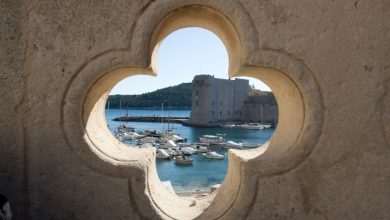If one was to single out the most Dalmatian, or the most Mediterranean of all the Croatian music phenomena, they would most certainly decide in favour of klapa singing, which represents the ideal combination of traditional and popular, with a positive craving to spread outside of Dalmatia’s borders, and outside the devised borders of the Mediterranean. In musical terms, this is a homophonic style of singing that evolved from the typically traditional form of singing (the klapa song) and existence (klapa) to an expertly set, organised form of singing, which is considered today to be a form of popular rather than traditional music, due to the way it is presented.
The klapa singing phenomenon is a continuous and fairly old phenomenon brought to our attention by researchers and musicologists in the late 19th century (Kuba, Kuhač). The klapa and klapa song tradition that we know today was formed in the mid 19th century, at a time when Croatia’s cultural and musical identities of small Mediterranean coastal towns and islands of Dalmatia were being defined. The recognizable way of singing, a tradition of urban Dalmatia, developed when Dalmatian cities and townlets were growing, was influenced by organized music of Croatian national revival. It is a time when the first organized church and profane singing choirs came to being, as well as city brass bands (a legacy from Napoleon’s time) and tamboura bands and orchestras. The above-mentioned musical phenomena have directly influenced the development and popularisation of polyphonic, traditional, and urban singing.
The klapa was never an isolated phenomenon; the character, musical contents and ways of klapa singing have dynamically changed through different periods, accepting influences and variations from other cultures. These facts are the main reasons for the popularity klapa singing enjoys today, especially among the younger generations. Informal singers’ get-togethers have developed into organized musical activity over the past century, and have spread throughout the islands, coasts and hills of Dalmatia, only to become a distinguishing musical phenomenon in almost all of Croatia.
It is important to point out that in its beginnings, this way of communicating music was exclusively a male tradition. They were smaller groups of singers who were, except by close friendships, business and other interests, bound by love for songs, and love for creating music together. Fishermen and labourers sang alongside traders and craftsmen, pupils and college students, mostly in taverns, where, with a simple meal (salted pilchards, chickpea, broad beans, prosciutto, cheese) they would drink red and white wine. They would sing because they loved to, walking along narrow streets in search of hidden corners where their voice would best reverberate, bringing joy to the group. They sang for others, too, especially their beloved ladies, who a group of singers would serenade under their windows, until someone from their home took pity on them and opened their doors to them, offering food and drinks. Many female tourists have had the pleasure to experience the same, hearing the songs of Dalmatian gulls, typical Dalmatian men, who broadened the tourist offer of Dalmatia.
If you mention klapas or klapa singing anywhere in Croatia, or among Croatians abroad today, most will know what it’s basically all about. There will be those who would try to explain to you what kind of singing this is, trace it back to their summer holidays, the sun, the sea, wine and fish, cheese and prosciutto… Well, you’ll have to stop them there, because it is not easy even trying to explain how the klapas, or the klapa movement, work today.
It is exactly the intention of this festival’s edition – to make the public aware of the diversity of expression, models, geography, and performance opportunities (shows, meetings, festivals), that have, in the past twenty years, grown from a local musical phenomenon to a regional, even national one, and are on their way to become a global product of culture and tradition.
It is also its intention to show to a wider community the specificity and elements that make the klapa movement, and to avert their attention to every feature, style and genre. At the same time, it is our wish to dispel a few prejudices and turn a new page in the history of klapa singing. It doesn’t just belong to tradition, it belongs to the wider community – to every potential singer that will, by practicing this music, enjoy the singing itself and the fruits of their labour. A mitigating (but also an aggravating) circumstance, to us researchers and potential singing candidates, lies in the fact that the klapa movement is becoming more and more present in the media, and becoming recognizable, which makes this a lot easier in the beginning stages of practicing this kind of music. The klapa activity follows world trends that prefer polyphonic a cappella singing, which is a main characteristic of klapa singing. Absolutely positive in its nature, the klapa singing trend becomes a new identity for a wider area, it becomes popular music. There is only one, decisive step, from traditional to modern, and with this edition and our overall activity, we’re trying to educate the community about the specificities that make the klapa singing available and desirable. The Ministry of Culture of the Republic of Croatia has recently sent a proposition to UNESCO to make the klapa singing a part of intangible cultural heritage, that was built, nourished and presented to the world by generations of singers from islands, coasts and hinterlands of Dalmatia. May this festival be a modest thanks to the generations that left their heart and singing soul at the klapa circle and passed it on to new generations of singers.
source: www.aklapela.hr



